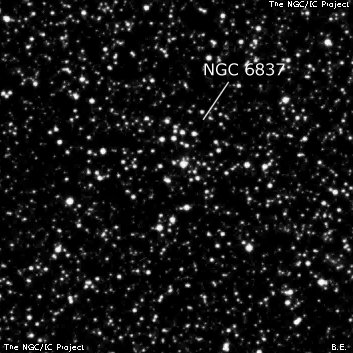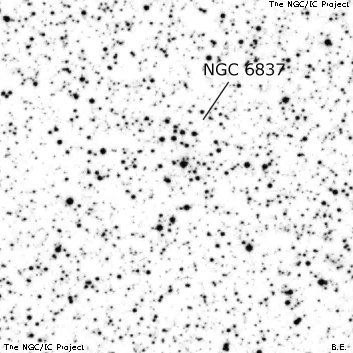NGC/IC Project Restoration Effort
(This is a very very beta version)
NGC6837


Basic Information
Location and Magnitude
Right Ascension: 19:53:8.0
Declination: +11:41:54
Constellation: AQL
Visual Magnitude: 12.0
Historic Information
Discoverer: Herschel W.
Year of discovery: 1784
Discovery aperture: 18.7
Observational
Summary description: Cl, S, P
Sub-type: OCL
Corwin's Notes
=====
NGC 6837 is probably a small cluster of about 15-20 stars 12th magnitude and
fainter, only six by three arcmin in size, centered about 3 arcmin west of
WH's nominal position. The position in the GC and NGC comes from JH whose
notes read, "Viewed. In place by working list? It is a coarse straggling
part of the Milky Way." He puts plus/minus signs on both RA and NPD, and the
position he publishes in his 1833 list does not come from the sweep. There,
the object carries the same description as published, but with the additional
note "No cl." The sweep has no position given, though there is a peculiar
notation that looks like an NPD with a few extra signs thrown in:
"+78[deg]-8'+15"." The position JH published actually lands in a region void
of brighter stars. It's no wonder that RNGC lists it as non-existent.
I suspect that JH did not see the cluster that his father did as his
description is not the one he uses for small clusters elsewhere in his
observations. It instead suggests a much larger cluster of near-star-cloud
dimensions.
WH himself is not much more informative: "A small forming cluster of
stars." He used the word "forming" literally as he interpreted the cluster
as a young object just settling into clusterhood. The only real clue we have
now is "small" and that fits the candidate object pretty well.
So, I think the best we can do is to simply ignore JH and go back to WH's
scanty observation. The position and sizes I have adopted is based on that.
Steve's Notes
=====
NGC 6837
17.5" (6/24/95): this asterism only stands out reasonably well at 100x. Consists of roughly 15 mag 12-14 stars in a 4' group elongated E-W. There is a small rich subgroup bulging out on the north side in a semi-circular arrangement (better resolved at 225x). Listed as nonexistent in RNGC.



